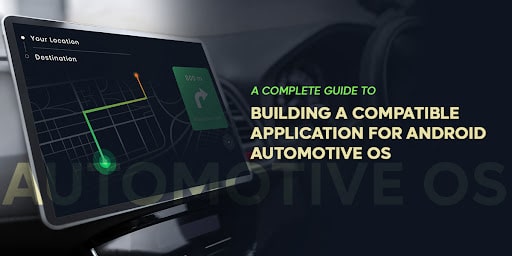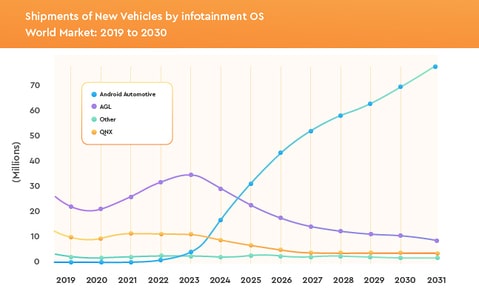Introduction
Android Automotive Operating System is commonly known as AAOS in the current Android in the preceding article. We have numerous forthcoming and evolving features being supported in terms of development and design concepts since this is a new arena for Android.
According to marketsandmarkets research, the automotive market is expected to reach $82.79 billion.
Users no longer need to connect their phones because they may download apps directly to the infotainment system in their car from the Google play store. Instead, customers will be using an interface created specifically for their automobile screen to view apps. This is what, in terms of usability and accessibility, makes AAOS apps so practical and helpful.
Here, you will look at how to make a general app on AAOS in this blog.
What is Android Automotive OS?
The connected services in cars should provide users with the same intuitive, thrilling experience they expect from their favorite consumer electronics gadgets, apps, and cloud services. Moreover, the vehicle is expected to integrate with their personal app ecosystem. Android Automotive OS makes all of this much easier.
A number of companies have already decided to collaborate formally with Google to develop their next-generation IVI, including Google Automotive Services (GAS). However, a third fraction is still on the fence about whether to develop an Android Automotive System based on AOSP, primarily because of uncertainty regarding dependencies and data ownership.
Development of apps for the Android automotive operating system
Today, you can see that vision in action with Android Automotive, which allows millions of users to bring apps from their smartphones into their cars. We have seen an increase in demand for Android Automotive OS from vehicle manufacturers in a relatively short period of time.
Click here for – Mobile App Development Company in Toronto
Categories of Android automotive apps in OS
The following categories for Android Auto and/or Android Automotive OS supports:
- Audio media apps – Audio content can be browsed and played through in-car media apps. On Android Automotive OS, you can create, test, and distribute media apps.
- Apps for Messaging – Apps that allow users to communicate in the car can receive incoming notifications, read messages aloud with text-to-speech, and respond using voice input. Android Auto allows you to create, test, and distribute messaging apps.
- Apps for navigation – Navigation apps, which include providers of driver and delivery services, assist users by providing turn-by-turn directions.
- Apps for finding points of interest – Users can discover and navigate to points of interest with POI apps, such as parking, charging, or fuel apps. Creating these types of apps can be accomplished using the App Library for Android for Cars.
- Apps for the Internet of Things (IoT) – IoT apps enable users to perform relevant actions on connected devices while driving.
- Apps for watching videos (for use while parked) – Users can watch streaming videos while their cars are parked using video apps. Android Automotive OS allows you to create, test, and distribute video apps.
What are the benefits of these apps for customers?
It’s going to be smart cars in the future! A connection between your car and your smartphone is part of the Internet of Things, as are third-party tools. Driverless cars will play a significant role in the coming years. Self-driving cars can already be called and moved using voice apps, and cloud-based apps will impact manufacturing web apps with over-the-air software.
A new section of automotive apps opens up with the addition of manufacturing mobile applications that emphasize security. By sharing data, you can access information about the car directly from your app, diagnose car problems, and even park it. These are Internet-connected cars. It is a very lucrative market since there aren’t many dedicated players.
App developers have to work closely with car engineers to create the ‘brain’ for the vehicle. The car systems must contain code that integrates hardware and software. Data collection for a smart car begins on the car’s production floor when the manufacturer collects and analyses the data.
Building a ‘brain’ for a car requires a lot of work and coordination with app developers. To integrate hardware and software, you must embed code in the car systems. Data collection for a smart car begins on the car’s production floor, when the manufacturer collects and analyses the data.
Challenges with google automotive services
- Inadequate documentation and communication – Developers and mobile groups are expressing their dissatisfaction, with some attempting to open a line of communication with Google.
- Improving the AAOS user experience – They can change the colors, typography, layouts, and other elements. Design patterns are still required for automotive, and Google provides an entire design system page.
What are the most recent trends in automotive app development?
Developing an automotive mobile app that is simple does not provide users with an unforgettable experience, which is what users seek. Current trends are as follows:
- Connect automotive mobile apps to wireless musical instruments, Wi-Fi, and other advanced connectivity technologies.
- Assist with driving, parking autonomously, and other features.
- Implement connected vehicle technology, which detects vehicle activities such as speed and performance.
- Data on speed, driving behavior, brake patterns, and other variables should be collected, sorted, and shared through a telematics-compatible app.
- Users can access the cloud or optimize routes using internet connectivity.
Factors to consider when developing manufacturing applications
1. Market research
In market research, you can ask, which requirements will add value and ensure the most profit in terms of ROI and the best bang for your buck? What technical challenges would you face, and what are your limitations?
2. Ideal developers
Experience with AI is also beneficial, especially when it comes to inspecting and identifying defects in automotive components, parts, and products.
3. Appropriate mobile technology stack
The automotive industry requires specific functions, such as integrating the app with third-party APIs and leveraging IoT platforms, as well as installing specific hardware and Bluetooth devices in vehicles. Who are you developing the app for? Do they use Android, iOS, or a combination of the two?
4. App development, security, and testing
Many glitches can occur when connecting hardware and software, so you must have your mobile app testing in place. Will you develop your own apps or rely on off-the-shelf platforms? Remember that IoT is drastically changing this market, and linkage between hardware and software is critical. The car manufacturing industry is constantly changing as a result of manufacturer-backed mobile app development.
What to anticipate in the near future?
After all, the purpose of AAOS is to standardize what we will see in our cars. It brings the most frequently used applications without the need to plug in the phone. You can use the favorite navigation app to create shortcut icons for frequently visited locations.
It appears that system releases are becoming more frequent, with Google adding features that are required to control everything correctly from various cars. Custom skins and screen customizations can add a personal touch to your vehicle.
Conclusion
The summary is about Automotive Android Operating System may indicate in terms of code and documentation. That appears to be the sentiment shared by the majority of the developers who have shared their experiences. It is risky to develop apps without a clear understanding of where the new Android is going and without a board or support medium, at the very least to bring developers together.
Have being said, now is an excellent time to launch your app and be the first to do so. Investigate what might pass the check and how far they will allow apps to develop.
We have provided some insights into the Android Automotive OS (AAOS) in this blog, which is publicly available on android.googlesource.com. We have explained the layered architecture and how the system can be expanded by the OEM in addition to the basic features, frameworks, and libraries.
Also, we consider Android Automotive OS to be a powerful platform that includes all essential core features. Connected infotainment systems necessitate lower development, integration, and maintenance costs. Although the system can be completely customized, any deviation from the original source code increases the OEM’s development and maintenance effort.
Do you want to begin developing apps for AAOS? Or Are you looking for a reputable automotive software development firm? We are the leading Automotive IT Solutions Provider, and we can assist you in developing innovative apps for automotive purposes.


